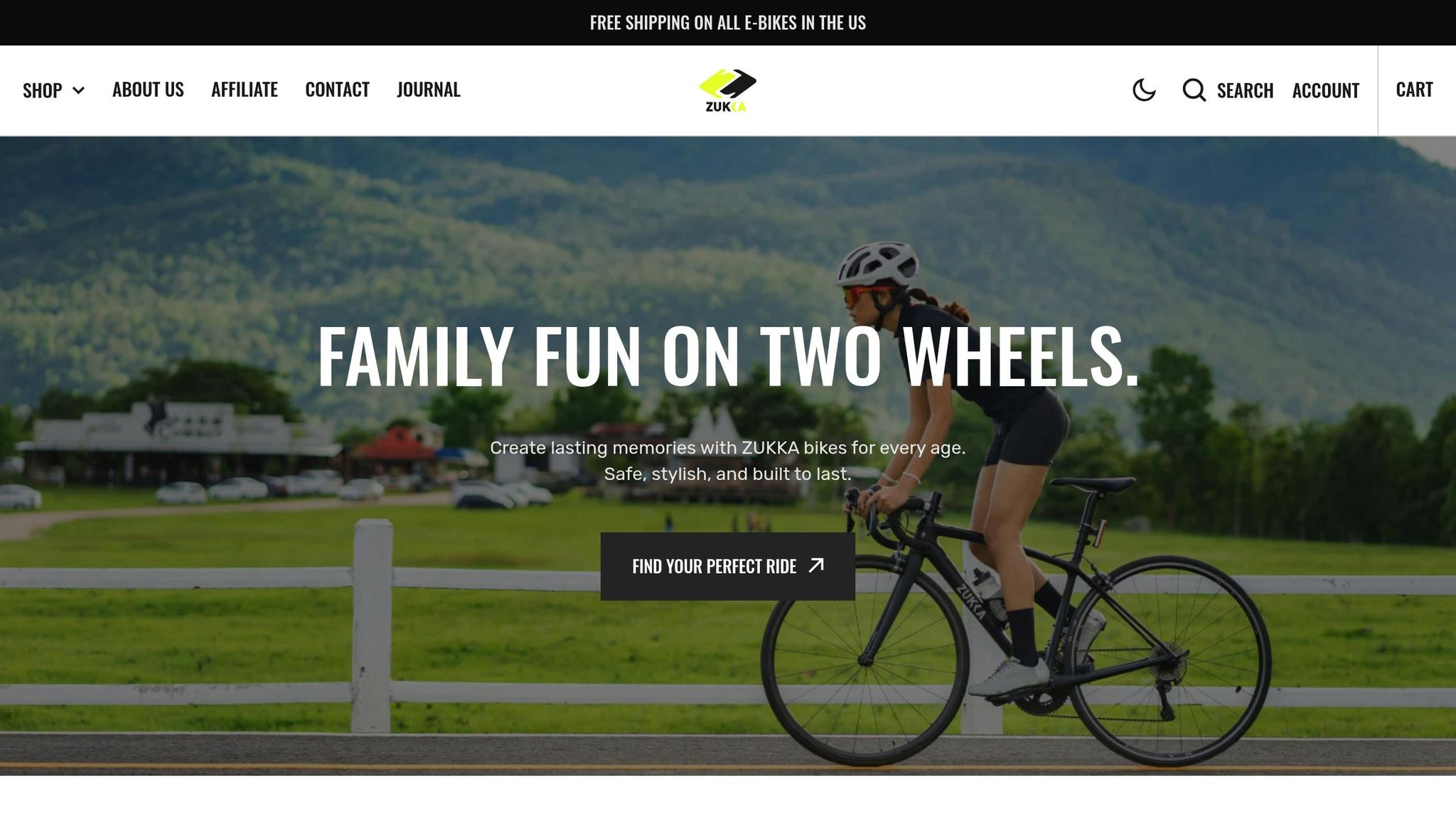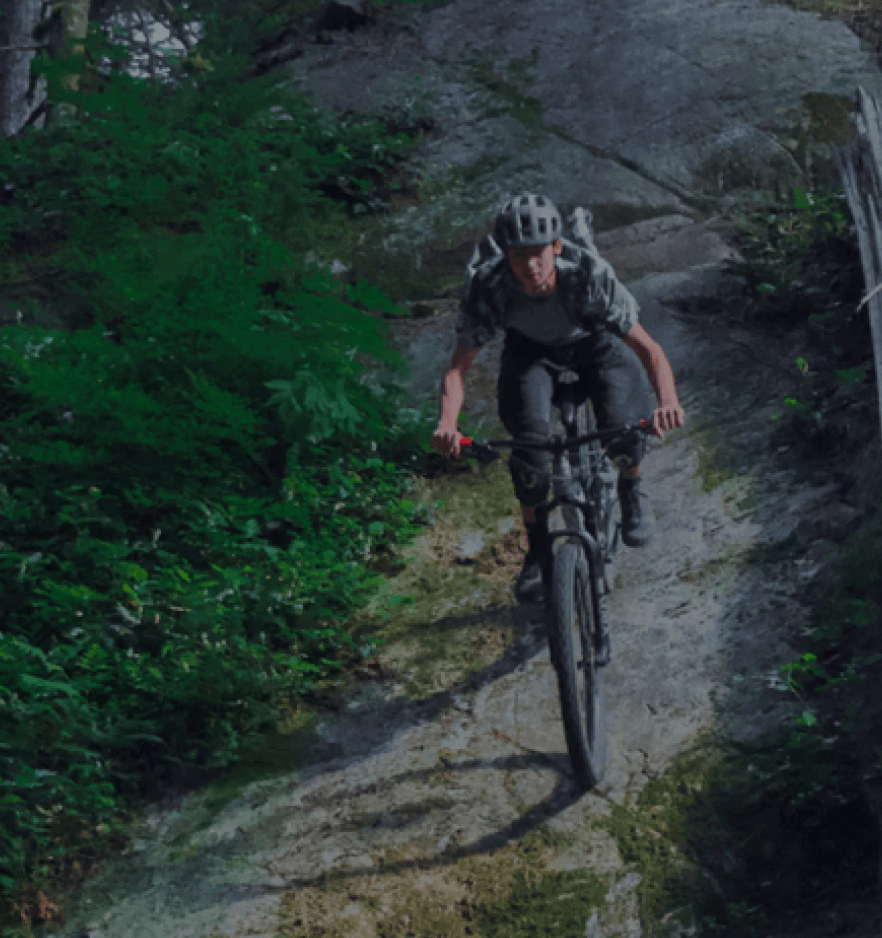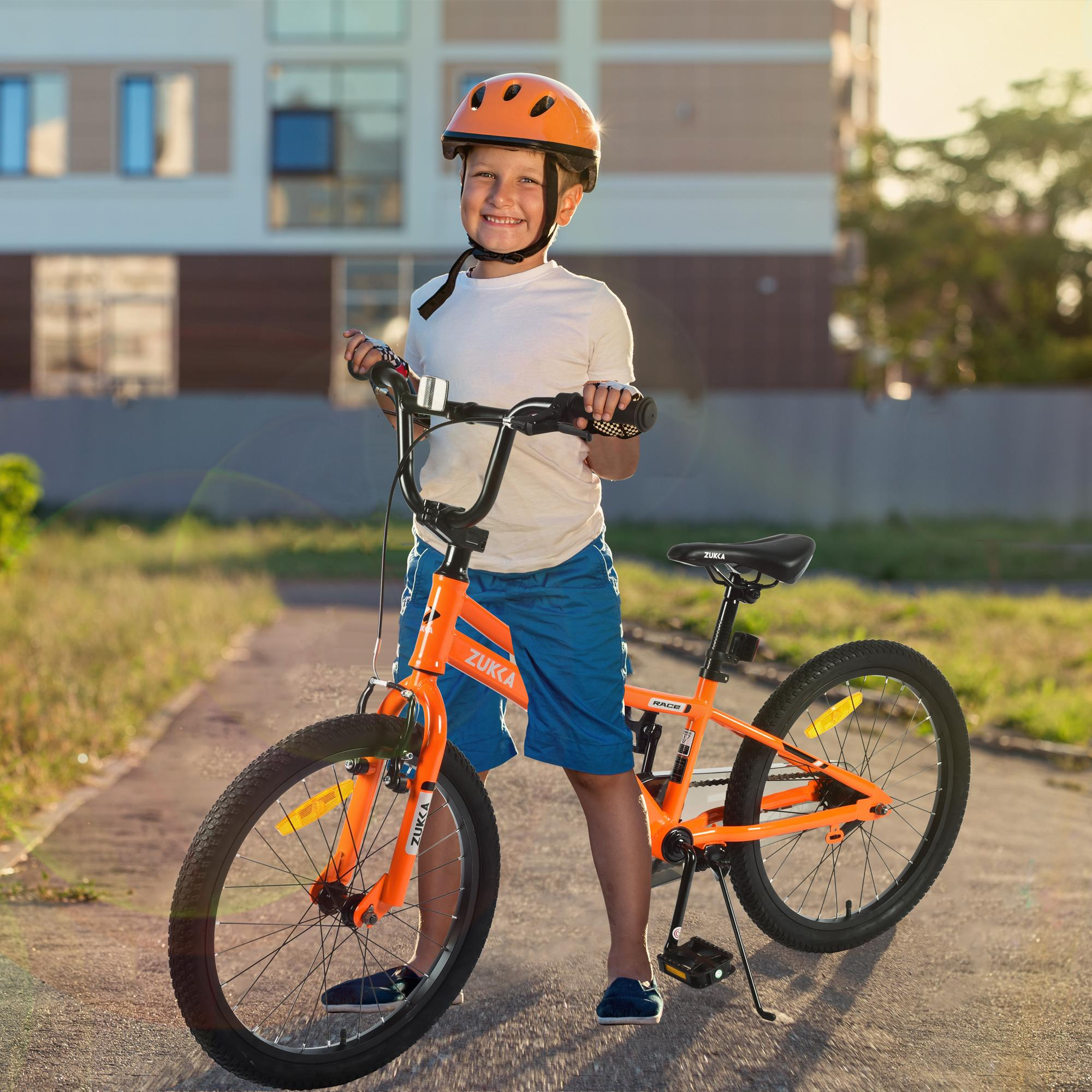Finding the right bike for your 3–5-year-old is all about proper sizing, safety, and comfort. Here's what you need to know:
-
Size Matters: Kids' bikes are sized by wheel diameter:
- 12-inch wheels: For ages 2–3, inseam 14–17", height 2'10"–3'4".
- 14-inch wheels: For ages 3–4, inseam 16–20", height 3'3"–3'8".
- 16-inch wheels: For ages 4–5, inseam 18–22", height 3'7"–4'0".
- Key Measurements: Use your child’s inseam (not just height) to ensure they can comfortably straddle the bike and reach the pedals and handlebars.
-
Safety Features: Look for:
- Chain guards to prevent injuries.
- Coaster brakes for younger kids, hand brakes for older ones.
- Lightweight frames and adjustable seats for better control and comfort.
- Training Wheels: Ideal for beginners, they can be removed as your child gains confidence.
Quick Comparison of Bike Sizes
| Wheel Size | Age Range | Height Range | Inseam Range | Best For |
|---|---|---|---|---|
| 12" | 2–3 years | 2'10"–3'4" | 14–17" | First bikes, balance bikes |
| 14" | 3–4 years | 3'3"–3'8" | 16–20" | Pedal bikes with training wheels |
| 16" | 4–5 years | 3'7"–4'0" | 18–22" | Confident riders, advanced features |
Tip: Always prioritize fit over age or "growing into" a bike. A well-fitted bike ensures safety and builds confidence, laying the foundation for a lifelong love of cycling.
How To Pick The Right Bike For Your 3 Year Old Child full length
Key Measurements for Bike Sizing
Getting the right bike size for your child is all about accurate measurements. A properly sized bike not only keeps your child safe but also helps build their confidence as they ride. The inseam is the most reliable measurement for sizing a kids' bike - it’s far more accurate than using height alone. While age can offer a general idea, it’s not dependable since kids grow at different rates.
Height and Inseam Measurements
Measuring your child at home is simple if you follow the right steps. Here’s how to do it:
Start by having your child wear the shoes they’ll likely use for biking. Have them stand straight with their back and heels against a wall. Place a book between their legs, raising it until the spine presses firmly against their crotch. Make sure the book is level with the floor, then measure from the ground to the top of the book’s spine - this gives you their inseam. For height, measure from the floor to the top of their head while they stand upright.
When buying a bike online, compare your child’s inseam to the bike’s stand-over height. The inseam should be longer than the stand-over height so your child can easily straddle the bike.
| Wheel Size | Age Range | Inseam Range | Height Range |
|---|---|---|---|
| 12" | 2 to 3 | 15–18" | 36–39" |
| 14" | 2 to 4 | 15–20" | 37–44" |
| 16" | 4 to 6 | 16–22" | 41–48" |
While body measurements are crucial, age guidelines can also provide some context when picking the right size.
Age Guidelines and Their Role
Age can be a helpful starting point, but it shouldn’t be your main factor when choosing a bike. Guardian Bikes explains:
"When purchasing a kids bike, you should never choose a bike size based on an age range that is listed on a sizing chart."
Why? Kids of the same age can vary widely in height and leg length. For example, one 4-year-old might be tall enough for a 16-inch bike, while another may feel more comfortable on a 14-inch model.
Age-based guidelines are best used alongside physical measurements. They can help you narrow down your choices, but the final decision should always be based on your child’s inseam and height.
For beginners, set the bike seat level with their inseam to help them feel secure. For experienced riders, raise the seat 2–4 inches above their inseam. This adjustment helps them ride with confidence while maintaining control.
Bike Sizes for Ages 3-5
When it comes to choosing the right bike for preschoolers, height and inseam measurements are key. Bikes for this age group typically come in three sizes: 12-inch, 14-inch, and 16-inch wheels. Each size is designed to match a specific stage of your child’s cycling development.
Here’s a closer look at how these sizes fit into your child’s biking journey.
12-Inch Bikes
12-inch bikes are best suited for kids aged 2–3 years who are between 2'10" and 3'4" tall, with inseams measuring 14–17 inches. These bikes are often the starting point for toddlers, especially as balance bikes without pedals. Balance bikes help young riders develop coordination and confidence before they move on to pedal bikes.
For younger or smaller 3-year-olds, or for kids just starting out, a 12-inch bike is a great choice. Its lower seat height allows both feet to touch the ground, giving kids a sense of security as they learn to balance and steer.
14-Inch Bikes
14-inch bikes are designed for children aged 3–4 years, with heights ranging from 3'3" to 3'8" and inseams between 16–20 inches. This size is a popular pick for preschoolers transitioning to their first pedal bike. Many models in this range include training wheels and coaster brakes, offering a stable platform for building pedaling skills.
Because many kids in this age group fall in the middle of the height and inseam ranges, a 14-inch bike often strikes a good balance between room to grow and ease of use.
16-Inch Bikes
16-inch bikes are ideal for kids aged 4–5 years who are between 3'7" and 4'0" tall, with inseams of 18–22 inches. These bikes are perfect for taller preschoolers or those who have already mastered the basics on smaller models. Many 16-inch bikes feature hand brakes in addition to coaster brakes, giving confident riders more control and preparing them for more advanced biking.
Before choosing a 16-inch bike, make sure your child can comfortably reach both the ground and the handlebars. A proper fit is crucial for safe and enjoyable riding.
| Wheel Size | Age Range | Height Range | Inseam Range | Best For |
|---|---|---|---|---|
| 12" | 2–3 years | 2'10"–3'4" | 14–17" | First bikes and balance training |
| 14" | 3–4 years | 3'3"–3'8" | 16–20" | First pedal bikes with training wheels |
| 16" | 4–5 years | 3'7"–4'0" | 18–22" | Confident riders ready for more features |
When selecting a bike, your child’s inseam is one of the most important factors to consider. Avoid buying a bike that’s too large with the idea that they’ll "grow into it." A well-fitted bike not only makes riding safer but also helps build confidence. Up next, we’ll dive into the key features that make these bike sizes safe and fun for young riders.
sbb-itb-4ec432b
Important Features in Bikes for 3-5 Year Olds
Getting the size right is just the start when choosing a bike for a preschooler. The features built into the bike play a huge role in ensuring comfort, safety, and an enjoyable experience. These details cater specifically to the needs of young children who are still building their strength, coordination, and confidence on two wheels.
Lightweight and Adjustable Design
A lightweight bike is much easier for a child to control and balance. Think about it this way: every extra 2.2 pounds on a child's bike feels like an additional 22 pounds on an adult's bike. Ideally, the bike should weigh less than 40% of your child's body weight. This keeps the ride fun and avoids unnecessary strain.
Adjustable features are another must-have. Bikes with adjustable seat heights and handlebars can grow alongside your child, ensuring a proper fit for years. This not only saves money but also keeps the bike comfortable and safe as your little one gets taller. A well-fitted bike boosts confidence and makes it easier for kids to balance and control their ride.
When shopping, check how easily the seat height can be adjusted to match your child's inseam. They should be able to sit and touch the ground comfortably with their feet. Once you’ve got the fit and weight sorted, it’s time to look at safety features that protect your child while they ride.
Safety Features to Look For
Safety isn’t just about finding the right size - it’s also about the bike’s built-in features. With approximately 254,000 children injured in bicycle-related accidents each year, thoughtful safety additions are non-negotiable.
Chain guards are a great example. They keep little fingers and clothing safe from the moving chain. As for stopping power, reliable brakes are key. Coaster brakes (the kind you activate by pedaling backward) are ideal for younger kids who may not have the hand strength for hand brakes yet. For older preschoolers, hand brakes offer more control.
Visibility is another big factor. Reflectors and other visibility aids help keep kids safe in low-light conditions. Ergonomic handlebar grips and appropriately sized components make it easier for small hands to maintain control, while steering limiters on some models prevent sharp turns that could lead to falls.
And don’t forget the helmet! A properly fitted helmet reduces the risk of serious head injuries by more than 80%. Universal helmet use could even prevent hundreds of deaths each year. Alongside safety features, removable training wheels can help ease the transition to independent riding.
Removable Training Wheels
Training wheels provide stability and help kids gain confidence as they move from tricycles to two-wheelers. They’re especially helpful in reducing the fear of falling, which can be a big hurdle for young riders.
The best part? Training wheels are removable, making them a flexible option. They can be attached to most kids' bikes and taken off when your child is ready to ride on their own, extending the bike’s usability. This gradual transition helps kids develop coordination and motor skills at their own pace. When picking training wheels, look for ones that are adjustable, durable, and compatible with your bike size. Make sure they can handle regular use and meet your child’s weight requirements.
ZUKKA Bikes for Preschoolers

Once you've figured out the right size and safety features for your child, it's time to explore bikes that balance quality and affordability. ZUKKA bikes stand out for their lightweight, adjustable designs and thoughtful safety features, making them a solid choice for preschoolers starting their cycling journey. These models reflect the principles of design and safety we've discussed earlier.
ZUKKA Models for Ages 3-5
ZUKKA offers two standout options for preschoolers: the ZUKKA Zoomer 16" Kids' Bike and the ZUKKA Nova 16" Girls' Bike. Both are tailored for young riders, particularly those in the preschool age range.
- ZUKKA Zoomer 16" Kids' Bike: Priced at $119.00 and weighing 21.49 lbs, this bike is built for easy control. It features a sturdy steel frame and a dual braking system, combining V-brakes and coaster brakes, which helps kids develop their braking skills gradually.
- ZUKKA Nova 16" Girls' Bike: At $129.00 and weighing 24.25 lbs, the Nova shares many features with the Zoomer, including a durable steel frame and dual brakes. However, it also includes a front basket for carrying small items and anti-skid 16×2.4 tires, ideal for smooth rides on sidewalks, parks, or streets.
Both models are equipped with training wheels to help kids gain confidence as they learn to ride. They also have closed chain covers to protect little hands and fingers. Plus, the bikes are designed to grow with your child, thanks to their adjustable components. For added convenience, both arrive 85% pre-assembled and include basic tools, making them easy for parents to set up.
Comparison of ZUKKA Bikes for Preschoolers
Here's a quick breakdown of the key features of these two models:
| Feature | ZUKKA Zoomer 16" | ZUKKA Nova 16" |
|---|---|---|
| Price | $119.00 | $129.00 |
| Weight | 21.49 lbs | 24.25 lbs |
| Recommended Age | 4–7 years | 4–7 years |
| Rider Height | 41″–45″ | 41″–53″ |
| Frame Material | Steel | Steel |
| Brakes | Dual (V-brake & coaster) | Dual brakes |
| Training Wheels | Included | Included |
| Chain Guard | Yes | Yes |
| Special Features | - | Front basket, anti-skid 16×2.4 tires |
| Assembly | 85% pre-assembled | 85% pre-assembled |
The Zoomer is the lighter and more budget-friendly option, making it perfect for families focused on simplicity and value. On the other hand, the Nova offers a wider height range and includes a front basket - an extra touch many kids love for carrying their treasures.
Both bikes are designed to help preschoolers build confidence and skills as they transition from tricycles or balance bikes to their first "big kid" bicycle. With 16-inch wheels, they're ideal for kids aged 4–7 years or those between 41–53 inches tall. Whether it's the Zoomer or the Nova, these bikes are ready to make your child's cycling experience safe and fun.
Conclusion
When it comes to picking the right bike for your 3–5-year-old, it all boils down to three key factors: accurate sizing, safety features, and overall comfort. Chris London, a community relations official with Performance Bicycle, highlights a common mistake parents make:
"One of the common things we see is people looking to get the largest bike that they can prop the child up on, and I think that's oftentimes a buying mistake when they do that... what you end up doing when the child can't comfortably or safely reach the ground is I think you take away the confidence of the child, and I think they're going to typically learn at a slower rate if they're not comfortable on the bicycle. Or they might just reject wanting to get on it altogether."
Getting the measurements right is crucial for your child’s safety and confidence. Since many kids start exploring two-wheelers around age three, ensuring the bike fits properly can make a big difference in how quickly and happily they take to riding.
"The best indication of which size is right for your child is how comfortable they feel on the bike." - REI
A well-fitted bike allows kids to securely touch the ground and manage the brakes with ease. Features like lightweight frames, adjustable parts, and dual braking systems help young riders gain skills at their own pace.
This focus on safety and adjustability is central to ZUKKA’s preschooler models. Both the Zoomer ($119.00) and the Nova ($129.00) are designed with growing riders in mind, offering the safety features and flexibility kids need. As Forbes puts it:
"ZUKKA brings thoughtful design to affordable urban bikes"
Choosing the right bike size can turn a potentially frustrating learning process into an enjoyable adventure. A well-fitted bike not only builds confidence but also lays the foundation for a lifelong love of cycling.
FAQs
How can I measure my child’s inseam to find the right bike size?
To get an accurate inseam measurement for your child, have them stand straight with their back and heels against a wall. Take a sturdy book and place it between their legs, raising it gently until it’s snug against their crotch. Ensure the book is level with the floor. Next, use a tape measure to determine the distance from the top of the book to the ground. For the best results, have your child wear the shoes they’ll be using while biking. This measurement is key to picking a bike that fits well and keeps your child safe and comfortable.
What safety features should I consider when picking a bike for my 3-5 year old?
When choosing a bike for your 3-5-year-old, safety should come first. Start by ensuring they have a well-fitted helmet to protect their head. You might also want to add knee and elbow pads to help cushion any tumbles.
Pay attention to features like a chain guard, which keeps clothing and little fingers safe, and brakes that are easy to operate for small hands. Bikes in bright colors or with reflective details are a smart choice, as they make your child more visible, especially in low-light conditions like early mornings or evenings.
By prioritizing these safety features, you can help your young cyclist enjoy their biking adventures with peace of mind!
Why shouldn't I buy a bike that's too big for my child to grow into?
Choosing a bike that's too big for your child in hopes they'll "grow into it" can actually do more harm than good. A bike that's oversized is tougher to handle, making it more likely for your child to lose control or have an accident. Plus, it can feel awkward or even intimidating, which might take the fun out of riding and discourage them from learning.
The right-sized bike is key to your child’s safety and confidence. They should be able to touch the ground with their feet comfortably - this is especially important for kids aged 3 to 5, who are still mastering their balance and control. By choosing a bike that fits properly, you’re setting them up for a safer, more enjoyable experience that makes riding a source of happiness, not frustration.


